Culture Grrl was alert enough at a press preview for Pictures Generation at the Met to realize that one person worth talking to (Douglas Crimp) was there but not talking. (Her interview here.)
Pictures Generation builds on the base of Crimp’s Pictures exhibition at Artists Space in 1977. Crimp is good at theory, not necessarily on how it plays out in the work of individual artists. Also, with 30 years of hindsight, Met curator Douglas Ecklund is in a better position to judge who belongs in this media-saturated group.
My problem isn’t who’s in and out, it’s how they’re out. Philip Smith is the only artist in Crimp’s show who isn’t in the Met’s. (In Crimp’s own reevaluation of his exhibit in a 1979 issue of October, he played down Smith and added Cindy Sherman.)
Fair enough. Smith doesn’t fit. The glue of their ideas does not adhere to him.
But curator Ecklund goes out of his way to tell both Culture Grrl and Jess Wilcox (excellent Art in America interview here), that Smith’s work just doesn’t cut it aesthetically.
Crimp speculated to CG that Smith’s omission might be because he’s gay.
Culture Grrl: What do you make of Philip Smith’s absence from the Met’s show?
Crimp:
He was not so much of the group, of the social world, of the people who
formulated this. He’s gay and this [the Met’s show] is a very straight
configuration of artists. I don’t know what’s happened to him,
career-wise. It’s a slightly touchy subject: I think Philip is upset,
reasonably.
Well played, Mr. Crimp. You stuck it to the establishment without defending Smith at all. It’s the perfect expression of your porcupine position.
I haven’t seen Smith’s work in a number of years, but I remember it well. I’ll take him over at least half of the artists in this show. Within the arena in which he chooses to act, his dense yet fluid congestion of signs and symbols continues to ripple out, influencing others.
A 1996 review in Art in America by Lily Wei zeroed in on their specific qualities:
The seeming spontaneity of the drawing is balanced by the deliberate
richness of the meticulously worked grounds. These elegant surfaces,
marked out in broad bands or grids of mustard yellows, lucid
gray-greens, sea and sky blues, along with black and white, are toned
down from Smith’s works of a few years ago, when figure and ground
competed fiercely for attention. The appeal of these paintings is a
perverse one. They can stymie or enchant, according to the viewer’s
sympathies.
So did Michael Kimmelman in a 1992 NYT review:
It is understandable that Philip Smith’s paintings did not stand out at
last year’s Whitney Biennial. They’re quiet works that do not try to
compete for attention. The considerable pleasure of them comes from the
painstakingly constructed oil and wax surfaces into which are incised
myriad images, like hieroglyphs. Mr. Smith builds layer upon layer,
first painting abstractions on linen and then covering them up, often
with subtle stripes of color, and on top of these laying down the final
soft surface. The incisions reveal the painting underneath, so that the
result is a multiple image of swirls of color beneath geometric designs
beneath loopy drawn pictographs of matchbooks, corncobs, skyscrapers,
grapefruits, clocks, fingerprints, African carvings and much else. Mr.
Smith’s inspiration seems to have come from many directions, from Brice
Marden and Mark Tobey and Jackson Pollock and also from Egyptian art
and even from the graffiti carved in antique monuments. But there’s a
combination of slowness in his surfaces and patterns, and speed in the
rush of cacophonous imagery, that is distinctive to him.
I hope Ecklund’s haughty attitude comes back to bite him. Below are a few of artists in Smith’s debt.



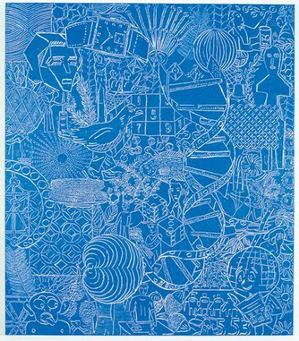
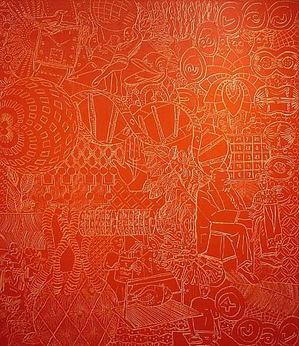
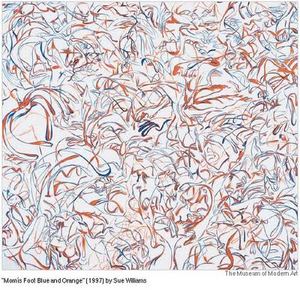
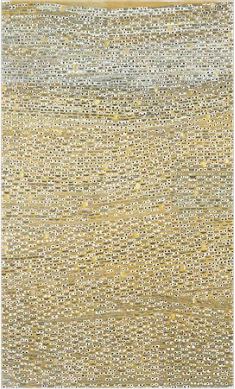
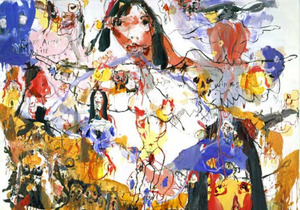
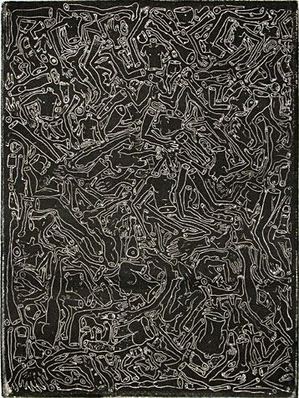
Hey Regina,
great minds think alike. After touring the show for the press preview, I too was astounded at what seemed a concerted effort to erase Philip Smith’s presence from the original “Pictures” show. I’ve known Philip for years(we showed with the same Soho gallery in the 80’s and have a German gallery in conman) and I like his painting. This is a prime example of the “establishment” trying to streamline history. The Smith story should be an object lesson to the thousands of other mid-career artists who find them selves relegated to invisibility, not because of their talent but due to shitty politics.
Philip Smith was omitted from the “Pictures” show because ha had not mantained a presence in New York City; when he made the conscious decision to move back to his hometown at the turn of the century, and no longer maintain a connection to a gallery here, he effectively became invisible. The myopia of certain curators and critics is exceeded only by their love of the tried and true (read flirtations with big name galleries here). Its easier to visit the galleries and surf the net than to do your homework.
Exactly.